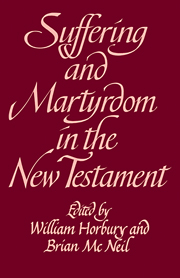 Suffering and Martyrdom in the New Testament
Suffering and Martyrdom in the New Testament Book contents
- Frontmatter
- Contents
- Abbreviations
- G. M. Styler and the Cambridge New Testament Seminar
- 1 Introduction
- 2 Did Jesus teach that his death would be vicarious as well as typical?
- 3 Imitatio Christi and the Lucan Passion narrative
- 4 The persecution of Christians in John 15: 18–16: 4a
- 5 Interchange and suffering
- 6 On the interpretation of Colossians 1: 24
- 7 Preparation for the perils of the last days: 1 Thessalonians 3:3
- 8 Maintaining the testimony of Jesus: the suffering of Christians in the Revelation of John
- 9 Martyrdom and inspiration
- 10 Suffering and martyrdom in the Odes of Solomon
- 11 Suffering and messianism in Yose ben Yose
- 12 What might martyrdom mean?
- Index of authors
- Index of references
- Index of subjects
5 - Interchange and suffering
Published online by Cambridge University Press: 26 February 2010
- Frontmatter
- Contents
- Abbreviations
- G. M. Styler and the Cambridge New Testament Seminar
- 1 Introduction
- 2 Did Jesus teach that his death would be vicarious as well as typical?
- 3 Imitatio Christi and the Lucan Passion narrative
- 4 The persecution of Christians in John 15: 18–16: 4a
- 5 Interchange and suffering
- 6 On the interpretation of Colossians 1: 24
- 7 Preparation for the perils of the last days: 1 Thessalonians 3:3
- 8 Maintaining the testimony of Jesus: the suffering of Christians in the Revelation of John
- 9 Martyrdom and inspiration
- 10 Suffering and martyrdom in the Odes of Solomon
- 11 Suffering and messianism in Yose ben Yose
- 12 What might martyrdom mean?
- Index of authors
- Index of references
- Index of subjects
Summary
In a book published more than twenty years ago, which he characteristically described as a ‘slight essay’, Professor Moule1 discussed what he termed the ‘strange paradox’ at the heart of Christian faith, arising from ‘the finality and yet constantly repetitive nature of salvation – the finished work of God in Christ, over against his continued work in the Body of Christ which is the Church’. It is one aspect of this tension, namely the relationship between the sufferings of Christ and those of Christians, that I wish to explore in this essay.
In previous essays on the theme of ‘Interchange’, I have argued for the importance of the theme of participation for understanding the Pauline view of redemption. In various key texts, Paul expresses the belief that – to adapt the words of Irenaeus – Christ became what we are, in order that, in him, we might become what he is. Christ identified himself with the human condition, bore the likeness of Adam, in order that men and women might bear his likeness and become children of God. Commentators have at times interpreted some of these passages in substitutionary terms, but a careful analysis shows that this is a misinterpretation. It is not a case of Christ becoming what we are in order /that we might become what he once was. If we experience glory and life as a result of Christ's self-humiliation and death, then this is because he himself has been raised in glory; if righteousness comes to us as a result of Christ being made sin, then this is because he himself has been acknowledged as righteous at the resurrection.
- Type
- Chapter
- Information
- Suffering and Martyrdom in the New TestamentStudies presented to G. M. Styler by the Cambridge New Testament Seminar, pp. 70 - 83Publisher: Cambridge University PressPrint publication year: 1981
- 3
- Cited by
